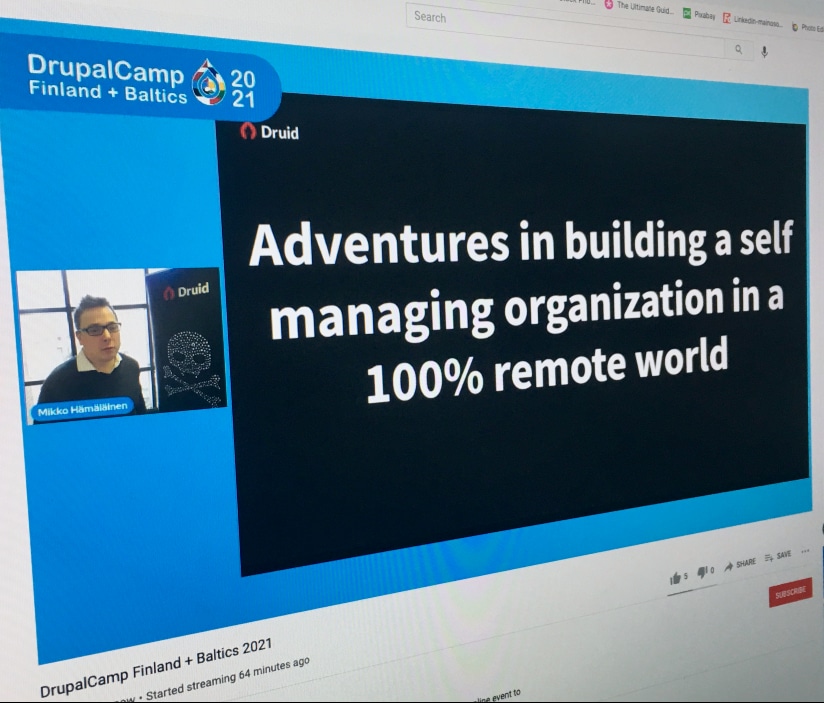
The road to self-organization
Self-organization is not a new concept in the software business. Self-organizing development teams have been a part of the discourse within agile software development for about twenty years now. Could the same sort of self-management be implemented at an organizational level? What sort of secrets and stuffy policies prevent having transparency and complete control of your own work at every level of an organization?
Everyone who’s ever tried delegating knows that it is hard to relinquish power, and that your own vision of the perfect end result for the task may differ from the vision or execution of the implementer. But even the worst micromanager will at some point realize that you can’t control everything. Particularly within specialist fields the greatest understanding of the best working practices, or whether the work at hand is even relevant, is with the expert working on the task and not with the management.
If we start off with the basic idea that you end up having in your payroll people that are in full possession of their faculties and who want to succeed at their work, where should you draw the line concerning authority? Can people decide for themselves what tools they use, what policies they follow on projects, when they take their holidays or what benefits they can enjoy?
Transparency is a prerequisite for working together
In the presentation I held at DrupalCamp Finland + Baltics (starts at 42:11) I went through how we have developed our organizational hierarchy and decision making processes here at Druid. We are a company founded by five owners, most of whom still work on every day “menial work”, which brings its own aspect to the company. For us it has enabled the development of a strong culture of self-organization.
My own experience has taught me that the biggest obstacle for self-organization is the lack of transparency. The company’s financial situation and projections are either only known by few or are too obscure to be of any use in the decision making process. Some of the information may be confidential for a good reason, but access to some of the data seems to be limited purely due to tradition.
Here at Druid the aspiration towards transparency has been built-in for the whole of our existence. We have conducted varying experiments and have gradually learned what works and what doesn’t. The biggest epiphany has been that raw data does not a happy druid make; if decisions are to be based on information, you will need interpreters for that information on every level of the organization. When systems can’t produce comprehensible data, you can shift some of the responsibility of clarifying that information to these interpreters.

Teal and self-organization at Druid
In practice, self-management is a very labor intensive management paradigm to implement. It requires actual shared responsibility, transparency and leaving your ego at the door. In addition, adhering to laws and directives can create headaches. Along the years we’ve experimented with different models of management and have met varying degrees of success in self-organizing. Now, in the latest effort to develop our organization, we’ve explored the Teal philosophy and are steering ourselves in that direction.
Teal is an organizational model introduced by Frederic Laloux in his book Reinventing Organizations. The model dismantles traditional power hierarchies and structures, allows for self-organizing with full responsibility for your own decisions and lets you be yourself, an autonomous human being, at the workplace.
Swarms, advice and conflict resolution
Our Teal organization is not completely without hierarchy. But instead of power hierarchies we have contextual hierarchies. Structures are created and removed according to need. For example, those of us that are interested in hardware acquisition can form an ICT swarm and start asking for bids on new phones or computers. If the swarm’s enthusiasm abates or if its goal is reached, the swarm ceases to be. The swarm commits to a certain goal and is responsible to the rest of the organization that it will provide value.
However, it is not practical to form a swarm for every decision. That is why we make use of an advice process. Each druid can, when identifying an issue, make a decision to fix it. The decision maker is expected to first seek advice from those affected by the issue and also the experts on the area the decision pertains to. The purpose, however, is not to reach a consensus: the power, but also the responsibility for the decision, is with the decision maker.
Getting others involved, and the fact that everyone is acting as themselves at the workplace, inevitably also leads to conflict. In the absence of a supreme arbiter, conflicts within the organization have to be settled in other ways, and we have a process in place for just this. It should be noted that conflicts should not be viewed as insurmountable obstacles but as learning opportunities.
We are in no way claiming to be a Teal organization through and through. There is still a lot of work to be done; old structures need to be relinquished while still keeping everything under control, transparency needs to be constantly increased, and people need to be inspired to take on the challenge.
We, however, are firmly on the road to becoming a teal organization, and are genuinely willing to give it a chance in the lean spirit.
PS. If this sparked your interest, you might want to take a look at our career site to see what we have to offer.

